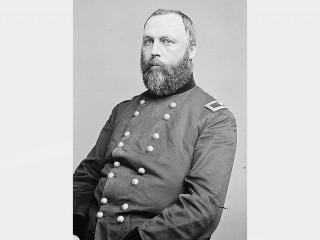
William Alexander Hamilton biography
Date of birth : 1828-08-28
Date of death : 1900-01-05
Birthplace : Annapolis, Maryland
Nationality : American
Category : Famous Figures
Last modified : 2010-06-08
Credited as : Neurologist and surgeon of U.S. army, President Abraham Lincoln,
0 votes so far
He spent a year working at the Pennsylvania Hospital in Philadelphia before moving to Saco, Maine, to establish a medical practice. Within a few months he abandoned his practice and joined the army as an assistant surgeon. He held the position for a decade, serving on army posts in the Southwest, Florida, Michigan, and Kansas. He also spent some time in Europe, studying the medical organization and services of armies there. During his travels Hammond conducted botanical and physiological investigations. He published books on his findings, some of which were reprinted in England and translated into German and French. His Experimental Researches Relative to the Nutritive Value and Physiological Effects of Albumen, Starch, and Gum, when Singly and Exclusively Used as a Food, published in 1857, won the American Medical Association's annual prize.
The Civil War.
In 1859 Hammond resigned from the army and became professor of anatomy and physiology at the University of Maryland. When the Civil War broke out he reenlisted in the army as an assistant surgeon. He helped establish army hospitals in Baltimore, Hagerstown, and Frederick, Maryland, before being transferred to West Virginia, where he became inspector of camps and hospitals under Gen. William Rosecrans. In an effort to improve medical administration in the army, the United States Sanitary Commission persuaded President Abraham Lincoln to appoint Hammond surgeon general in 1862. Hammond initiated several reforms in his new position, raising requirements for admission to the army medical corps; greatly expanding the number of general, post, and garrison hospitals; and working with the Sanitary Commission to create cleaner, less-crowded conditions in the hospitals. His efforts, as well as those of other reformers, resulted in a much lower hospital mortality rate than had been the case in previous wars. Hammond also supported plans, already in existence, for an army ambulance service and, in 1862, created an army medical museum. Despite his accomplishments Hammond's relations with Secretary of War Edwin M. Stanton were strained. As a result Hammond was court-martialed and dismissed from the army in the summer of 1864 on charges of making unauthorized purchases of medicine and other supplies. In 1878 Congress approved a bill to reopen the case, and in 1879 Hammond was exonerated on all charges.
Reentry into Civilian Life.
After returning to civilian life Hammond set up practice in New York and soon became a leader in the study of neurology, which was just beginning to draw specialized attention from the medical community. In 1866 he accepted a position as lecturer on nervous and mental diseases in 1866 at the College of Physicians and Surgeons in New York; the following year he became professor of nervous and mental diseases at Bellevue Hospital Medical College. He moved to several other institutions afterward, including the University of the City of New York, before establishing a sanitarium for mental patients in Washington, D.C., in 1889. He worked at the sanitarium until he died of heart disease in 1900. During these years he devoted much attention to the therapeutic properties of animal extracts.
Contributions to Medicine.
Hammond published extensively during his career. His works include On Wakefulness: With an Introductory Chapter on the Physiology of Sleep (1866), Sleep and Its Derangements (1869), and Insanity in Its Medical Relations (1883); his most significant work, Treatise on Diseases of the Nervous System, was published in 1871. Hammond also founded or cofounded several medical journals, including the Journal of Nervous and Medical Diseases, and published several novels and plays. By showing that at least some mental disorders were physically based illnesses that could be treated through medical means, Hammond pioneered the field of neurology in America. Had the conflict with Secretary Stanton not occurred, Hammond might have implemented even more hospital reforms as surgeon general. While his proposals to create an army medical school and a permanent general hospital in Washington were not accepted at the time, they would be realized in later years.
















